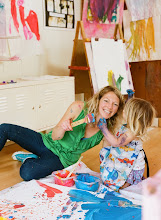
This week we focused on making our own textured paint. Each child was given a mixing bowl, a spoon, a textured ingredient (sand, sea salt, tissue paper), glue, flour, and a squeeze bottle of watered down tempera paint. They added each ingredient to the bowl and stirred and stirred until it was evenly mixed.




Once a thick paint was formed, each child scooped it out onto a large piece of tag board to begin their texture painting.


To move the paint around the boards, I offered the children a variety of scrapers- craft sticks, sand rakes, plastic putty knives, and plastic notched scrapers (usually used for tile grouting). Using these tools, the children scraped and pushed the paint around, watching the colors mix together to become new colors.




After experimenting with their first batch of textured paint, the children began to add more ingredients to their mix- like glitter, colored glue, more flour, and even collage items.


The thick rough texture of the paint also provided a new type of tactile experience!


In contrast with out thick textured paint, we later moved outside to learn about drip/splatter painting with very watery, thin paint. The children automatically wanted to put the brush to the paper until I demonstrated how holding the brush up high allows for the paint to drip down onto the paper. The older children got really into it, experimenting with different wrist and arm movements.


Jackson Pollocks in the making!

 This week we focused on clay. For their first introduction to clay, the new 1s class began with a soft, grainy clay, a rolling pin and a popsicle stick for poking. At first they really didn't know what to make of it. They were daring and tired to touch it, but quickly moved to the easels where they felt more comfortable.
This week we focused on clay. For their first introduction to clay, the new 1s class began with a soft, grainy clay, a rolling pin and a popsicle stick for poking. At first they really didn't know what to make of it. They were daring and tired to touch it, but quickly moved to the easels where they felt more comfortable. At this age I like to introduce children to clay on it's own at first, but eventually I always incorporate water to entice them. This brings them back to the table and helps them to engage more with the clay.
At this age I like to introduce children to clay on it's own at first, but eventually I always incorporate water to entice them. This brings them back to the table and helps them to engage more with the clay. Once the children felt more comfortable working with the clay, I began to introduce paint and various tools to use in their exploration.
Once the children felt more comfortable working with the clay, I began to introduce paint and various tools to use in their exploration. After getting to know the clay (hard work!), the children moved on to what they know and love... pure water play!
After getting to know the clay (hard work!), the children moved on to what they know and love... pure water play!
 The other 1s class are returning students with a little clay experience under their belts. So instead of the soft pliable clay I use with beginners, I offered them a modeling clay that is more firm and very smooth. Because it isn't as squishy as the other clay, it shows pokes and prints really well. The children began rolling, stamping, and poking the clay and seemed to be intrigued by this new material.
The other 1s class are returning students with a little clay experience under their belts. So instead of the soft pliable clay I use with beginners, I offered them a modeling clay that is more firm and very smooth. Because it isn't as squishy as the other clay, it shows pokes and prints really well. The children began rolling, stamping, and poking the clay and seemed to be intrigued by this new material.

 After a while, I offered the children more tools, paint, and water to use with their clay.
After a while, I offered the children more tools, paint, and water to use with their clay.

 This clay is soooo smooth- when combined with water it creates a sensory experience unlike any other!
This clay is soooo smooth- when combined with water it creates a sensory experience unlike any other!

























































